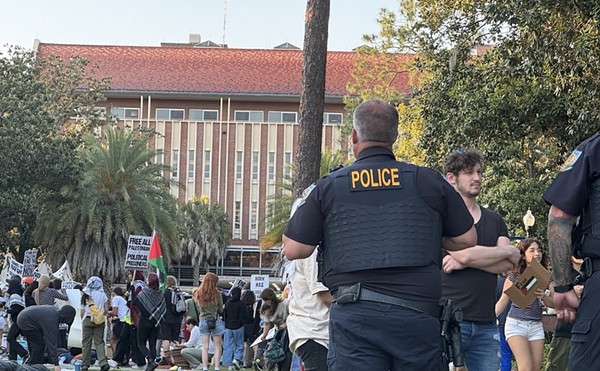An African proverb says, "Man dies and leaves a name; the tiger dies and leaves a skin." Indeed, our name identifies, legitimizes and quantifies our existence, and when we die, it holds our history.
What happens, though, if, through some dismal circumstance, we expire without identification, give up the ghost unbeknownst to family and friends?
Die like the tiger in this latitude and you become Orange County property, handed off to maybe a dozen people -- some you'd appreciate more than others. After due process -- expeditious or inefficient, depending, one has reason to believe, on your profile -- you are deposited in the county's lonely, unmarked paupers' field, a nameless number, in a three-acre patch of perditious dreams. No wreaths; no laments.
To the Orlando Police Department she is No. 99-185425; to the Orange County Medical Examiner she is BFX [black female unknown] 99-0571; to Postell's Mortuary she is Jane Doe 1890-144-99. But because there is one embroidered on her dress, I call her Rose.
It is midnight, May 21, and the landscaped promenade around Lake Eola -- downtown Orlando's glittery centerpiece -- is nearly empty. Police patrols make sure, especially after a faulty utility sensor caused a brief, early-evening blackout along the south walk. The colorful, dancing-waters fountain lies dark and still. The day's dust is adrift.
A creamy, first-quarter moonset occurs at 12:38 a.m.; at some later hour, beneath stars made dim by midtown neon, a body is afloat, face-up. Her head is slightly submerged, and so if her soul has lingered, it will view heaven wide-eyed, through shimmering, 79-degree, dyed-blue water. A mere whisper of wind -- 5 knots from the northeast -- caresses her buoyant hands, thighs, feet and belly, as she joins the gliding swans.
By the breakfast hour, Rose is in the hands of law enforcement.
It is just another trip for the driver of the white van that transports Rose from the lake through spring-sweet neighborhoods to her next layover. Reaching the county medical examiner's office, the van creeps up a steep ramp and pauses while the door to the morgue opens. The driver pulls inside and onto yellow marks painted on a large metal disk. A gear grinds; the disk begins a 180-degree turn -- a jerky, clockwise ride for a drying, warming Rose.
When the transport's back door is aligned with the receiving station, technicians open it, struggle to stabilize its cargo and put Rose onto a scale. The read-out of 345 pounds elicits wows and whistles. Somebody brings the body measure -- a stick with a heel stop. She is 67 inches long. On a chalkboard by the door, meager information about her is scrawled. The first entry: BFX ...
The medical examiner's findings on May 22 reveal little else: Age unknown. Fully clothed. No scars. No tattoos. No obvious trauma. Toxicology negative for drugs. Alcohol .035. Unknown medical history. No jewelry. No personal items. No money. No medications. Blue and strawberry pink nail polish. Brown eyes. Short, kinky, black hair, graying at temples. Manner of death: undetermined. Immediate cause of death: drowning.
Tom McDonald, chief investigator with the medical examiner's office for 25 years, has seen enough unclaimed corpses to populate a village. "They're usually in our custody a minimum of five days -- could be up to three weeks -- before we release them to a funeral home. During that time, law enforcement is supposed to try and identify them. Most often, they come up with at least a name.
"We interview fellow transients if they're homeless, friends if we can find them," he says. "If we can't find family, if friends can't or won't take responsibility for burial, if we've gotten no inquiries from the public, if there was no more information from OPD, then I contact the county's indigent burial program."
That program was seeded in 1888, by county commissioners concerned about the lives of the poor and the lack of decency and order in the interment of the indigent and unidentified. "Our helpless poor are not criminals, they are our equals before the law," the commissioners wrote.
The solution was a bucolic, residential, county poor farm -- on the site of the current Michigan Street government complex -- which provided a respectful, extended-family atmosphere, communal gardening and a final resting place called Orange Hill Cemetery.
In the decades since, decency and order have existed in varying degrees.
In 1961, three-coffins-deep and overflowing with 522 racially segregated, mostly unmarked graves, Orange Hill was closed by the county. After 35 years of languishing in the gloom of neglect, now, at least, its occupants rest beneath grass that gets mowed; a historical sign in a small flower patch along an adjacent, unpaved sidewalk announces that the dead still sleep there.
The current county graveyard opened in 1967, in a Union Park pasture just out of earshot of Highway 50 road-racket. Through a chain-link fence can be seen the adjacent Chapel Hill Memorial Gardens, whose dead rest in prosaic plots called "Babyland" or "Garden of Catholics" or "Masonic Garden." While Chapel Hill's dearly departed are honored with fresh flowers, plastic posies, plaster angels and Sunday-afternoon grievers, the least-of-the-county's brethren are lucky that their grass gets cut.
Rose's first week at the morgue, 19 deceased persons came and went; during her second week, another 23 passed through; week No. 3 brought 22; week four, 26. What set her apart from the 30 morgue mates of her fifth week was not only that she was still there, but that she was still unnamed and her pathologist's paperwork still uncompleted.
"She didn't really look like a homeless person," Investigator McDonald muses.
No, she didn't, despite her detective's file note that she was "possibly a transient, judging by her clothing." Rose's attire, though stained from the process of her dying, didn't necessarily suggest homelessness: But for two pairs of white socks worn with her white Coaster strap sandals, she did not dress in layers. Her navy-blue cotton jersey pants were in decent condition. Her Peachy Plus green dress, with its rose-bedecked, white-striped top, was worn as a blouse, perhaps because, on so large a woman, it was easier to keep tucked. That her underwear was cut-off cotton tights could have been for comfort. Finally, for a 65-degree spring night, the lightweight, purple Details Sportwear jacket she wore was perfectly appropriate.
Her anonymity nags McDonald. "Anytime I investigate an unknown I always wonder, 'Where is the somebody who knows them?' I know there's somebody out there who knows this woman. It's a shame ... .
"Yeah," he answers, "we work so many cases that we do tend to detach from any one person. But we keep paperwork on the desk to remind us to keep calls in to law enforcement, to make sure they have feelers out."
There were no feelers out for Rose, a fact that irks McDonald. "That's why we gave them a real good head shot we took at the scene. Most of the time the detective goes to all the homeless hangouts, takes fliers around town. That didn't happen for her. The Sentinel even refused to run her picture. I'm surprised. Here an unknown woman dies in a lake in the middle of the city -- why didn't they go back and pick up on it?"
A very brief Sentinel story ran on Saturday, May 23, at the bottom of page D-3, with incorrect and vague reporting: "matching sweat pants and top" (wrong); "blue or purple coat" (which?); "dark-skinned" (Hispanic? African American? East Indian?). It included her detective's cynical comment about the television reporters on the scene. "You know how it is, if it's downtown it will get a lot more attention than if it happens out in the more remote areas."
Attention? While WKMG-Channel 6 packaged the story for all its news broadcasts that day, WFTV-Channel 9 ran it once. WESH-Channel 2 won't comment on their coverage.
Across town, the county's indigent burial program waits, their required search for a financially responsible party thwarted by Rose's anonymity and bureaucratic foot-dragging.
Finally, though, release orders and purchase orders begin to make their way through the system, and Rose is scheduled for her next move: On July 7, nearly seven weeks after her death, she will at last be transferred to Postell's Mortuary, the venue currently contracted by the county to bury its forsaken and displaced dead.
The unmarked graves trouble Mike Benoit, director of the burial program who has been working for more than 10 years to improve the process and recently urged the county to install markers. "We'll see," he says.
Rose, though only the 22nd unknown, will be burial No. 650 in the county cemetery, which is divided into 20-foot-by-20-foot plots, each holding 15 people.
Benoit acknowledges he is pinched by poignancy when an unidentified body is among the 75 burials his program averages a year. "There were only two last year. This woman, though ... ," he says, echoing the complaint about the lack of publicity. "We needed her picture out there."
Rose's original investigator retired soon after her death and left her data on the bottom of his file pile. OPD Detective Ernie Moyer, newly transferred from Sex Crimes to Homicide, inherited her.
Moyer, understandably, wasn't up-to-speed on the case when he received a request for an interview, so he asked veteran homicide detective Barbara Bergen to accompany him. "Unfortunately, Ernie got left in the wake of somebody who left after 25 years, and he's stuck with the hard part," she says.
Moyer flips through pages: "Hmm, I don't have a cause-of-death or body chart," he says.
That's because, nearly two months after her autopsy, Rose also remained at the bottom of her pathologist's paper pile. (Only after a reporter's countless, unreturned phone calls escalated to complaints to the chief medical examiner would the autopsy report be completed -- on Aug. 17, a full 88 days after her arrival at the morgue.)
Moyer notes that a fingerprint check found no criminal record, no government employment, no military service.
What about dental records?
Bergen looks at Moyer who is looking at Bergen.
"Dental charts there?"
"None," he says.
(The next day, 24 hours before Rose's burial, a medical examiner's office technician would scurry to remove her bottom jaw and upper palate.)
What about interrogation of the transient community? Photos taken to bus and train stations? No fliers, no state or national missing-person queries?
"It should have been done," Bergen says, flatly. "It needs to be done; it could still be a productive search. It's a very big deal to find a person floating in Lake Eola in the middle of downtown, and we didn't even get the tips we would expect to come from just that fact.
"I don't like the thought of somebody ending up nameless in a pauper's grave; that's terrible," she says. "Sure, everybody wants their privacy respected, but it's important to always let somebody know where you are, even if family relationships are bad.
"I want to emphasize how very, very rare this is, though," she adds. "Less than 1 percent of cases that go into the morgue unidentified leave unidentified."
Although they have no clue how Rose ended up in the water, due to a lack of evidence the police presume a natural death. Any investigation now would focus on finding out who she is.
If he ever does get a copy of the autopsy report, Moyer will find a clue that sheds some light on Rose's age, guessed by the medical examiner to be 55-60: She had a uterine leiomyoma, a benign tumor that is estrogen-dependent. Had she been postmenopausal, as the M.E. suggests, experts say the tumor would not have survived. Further, leiomyomas cause copious menstrual flow -- evidence of which was found on Rose's undergarment but not mentioned in the autopsy report.
As Bergen talks, Moyer takes notes on how to unstall the case. He's not optimistic. "We're trained to find the bad guy, not the ordinary citizen. Thank God it's less than 1 percent; I don't know if I could handle, on a daily basis, the nightmare of trying to track down who these people are."
He stares at Rose's picture. "There is always a bond with somebody; for this poor lady here, there's nobody."
The morning of Rose's liberation from the morgue is hazy with heat and humidity, and although she will be transported to Rev. Henry L. Postell II's mortuary in a white Cadillac Concourse hearse, the reverend's gentlemanly assistant and driver, Isaiah Thompson, is concerned because the vehicle's air conditioning is broken.
The wheels on Rose's gurney protest as, at last, she's pulled from her parking place in the morgue's cooler; a rush of room-temperature air immediately begins to warm the red bag of coolant wedged between her legs. Beneath a sheet she is naked, her autopsy wounds gaping. Raising the shroud for a last look before Isaiah drapes a red funeral blanket over her, an attendant comments that Rose's face is giving way to mold and confirms by her red toe tag that she is BFX99-0571.
"Betcha somebody knows her -- you have to know she just didn't find that lake," Philip Hudson grumbles as he helps four men transfer her to the hearse's stretcher. " You have to know, too, she didn't jump in, didn't go for a midnight swim. What happened to her belongings? I'll tell you: Somebody took 'em."
"I blame law enforcement for her leaving here without her name," says the 25-year M.E. veteran and chief forensic technician who assisted at Rose's autopsy. "I know her detective, and he was as lazy as hell. Oh, they'll tell you, 'Well, nobody called' or 'We don't have time to go around.' Hey, you gotta work to find answers. Yeah, she's big and she's black, but that don't make her a bum, and she's got somebody somewhere."
En route to Postell's, as the mundane traffic of mid-week commerce passes, Rose shifts with lane changes; Isaiah watches her in the rear-view mirror. "Normally, they have 'em in a body bag; I'm thinking they didn't have one big enough for her. It don't bother me, though, having her close like this, because I know she's not here, it's just a body that she used for a little while," he says.
"I am concerned, though, that she has someone wondering where she's gone, while all along she's gone on to the Great Beyond."
At Postell's, Rose gets to enter through the front door, past the respectful employees, past the "Praise God" plaque, past the painting of twin owls staring from a bare branch, past a poem promising that her "woes and cares shall be released." In the next room, she rumbles by a wall display of pretty burial gowns with Velcro backs, including one of sequined, blue taffeta. Through another door, and she is deposited in a bleak, $40-per-day body-storage room with an overworked air-conditioning wall unit and a crowd.
"I don't get unknowns; however, we do get folks with two or three aliases. ... I treat everyone as though they were my own relative," Rev. Postell says sincerely. Of his county charges, he adds: "We try to provide final rites that anyone deserves -- dignity during burial. The sad thing with this lady is [that] the length of time she's been around brings a task we have to deal with."
Read: Cold storage in a waxed, cardboard box; no blue sequins, but a $100 black-plastic body bag; no $275 embalming, but powdering with a quick-lime compound.
If Rose were viewable, though, the reverend would fix her up nice and put her in the viewing room and take pictures, in case anybody did show up later looking for her. She'd get the full service, Scriptures and all.
As it is, she'll get the contracted $40 graveside prayer and committal service, document processing for $25, cemetery record-keeping for $50 and an internal identification tag for $5 -- that's the laminated sign on her chest that reads: Jane Doe, Found May 21, 1999, 1890-144-99 Postell's Mortuary, Unknown S.S. #, Orange County Cemetery.
As the calendar turns from July 7 to July 8, 9, 10, 11, a patient Postell is getting weary with the wait, and he has a bunch of bodies. "We've asked the county again, please, since she is unidentified and in advanced stages of decomposition, to expedite this so I can get her buried."
It doesn't happen until July 23. Ironically, the banner Sentinel headline that morning reads: "Farewell" -- not for BFX, but for JFK Jr.
You're close to the cemetery turn-off when, just past the East Orlando Feed store, the East-West Expressway looks like it's arching into heaven. Postell's hearse slows, turning north at the corner where Blevin's Court offers weekly rates and free HBO. Rose rides past the Church of Christ, past trailer courts and over the Little Econ before taking her last earthly left turn. Rusty and hidden by wild grape vines, the small sign says it all: Dead End.
The narrow dirt lane, encroached on both sides by wild blackberries, palmettos and tall stands of sour weed, borders, on the north, a water-treatment pond. To the south, in Chapel Hill territory, a lovely, fountained lake seems taunting.
Rose's tiny cortege of three funeral home personnel, two county employees, a reporter and a photographer creep along through deep muddy dips. The first gate, a tenth of a mile along, belongs to a run-down horse farm; another tenth of a mile is the county gate. No cemetery sign, just an old vehicle tag wired there that reads, "Orange County."
The air above the burial field is empty of birds, but a congregation of mourning doves watches silently from a power line. The perimeter fence holds back sumac and tangling undergrowth. A red hawk soars from adjacent woods and circles. Here ants work a hill. There a mole tunneled last night. Light wind groans through the graveyard's only trees -- a trinity of old pines and a pair of scraggly scrub oaks.
The group finally reaches the designated ground and, standing beneath a yellow sky, watches Joey Payment atop his Massey-Ferguson 30E backhoe dig the hole to hold Rose's bones.
Rose, reposing on the bottom-dollar crepe of her oversized $498 coffin, waits.
Atlas Concrete, Payment's family business, is contracted to provide the cement vault ($290) that will hold her coffin, and the opening and closing of Rose's piece of earth ($275). Of the event, Joey says: "It bothers me some -- nobody being able to find out who she is; it makes me wonder."
Then, all fall quiet as Rev. Postell touches the casket and begins his heart-felt committal: "Father God, into Thy hands we commend this sister. Although her name is unknown to us, yet, oh God, You know, and we commend her spirit to You."
Moments later, startled onlookers hold their collective breath when the attempt to lift and lower the coffin into its concrete vault falters: Under the weight of such a burden, chains secured to the coffin's corners shift, crunching metal. Rose, for an instant, swings precariously.
Divine intervention prevents a ghastly mishap, and the last words of the Lord's Prayer rise to heaven on the roar of the Massey-Ferguson, as it hurries to fill the grave. In the end, the reporter leaves a purple rose -- for a rose, unnamed, is still a rose.
"You know," says the preacher, walking away, "they come back yesterday and took her teeth out."


















